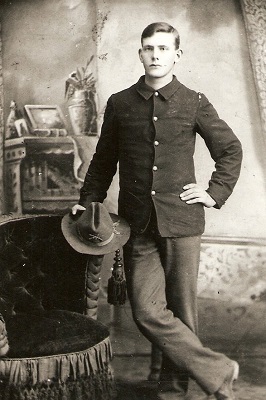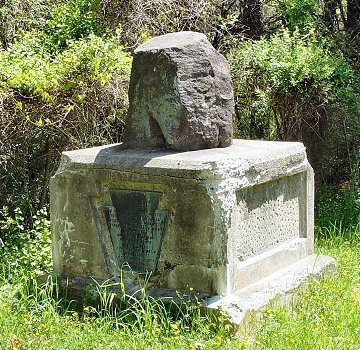
A Brief History
of the
Sixteenth Pennsylvania Volunteer Infantry
By Patrick McSherry

Photo
of Charles Rice Walker of the 16th Pennsylvania Volunteer Infantry,
Co. B of Duck Run, Lawrence County, Pennsylvania. Walker was eighteen
years old when he enlisted. After the war, he married Lillie Belle
Shaffer and the couple had seven children Walker was a coal miner and
in 1926 was trapped in a mine cave-in for twelve hours. Walker
eventually moved to California where he passed away in 1958.
Please Visit our Home
Page to learn more about the Spanish American War
Click
here for a history of the Puerto Rican Campaign
General:
The Sixteenth Pennsylvania Volunteer Infantry saw action in Puerto
Rico during the Spanish American War.
Unit History:
The regiment, under the command of Colonel Willis J. Hulings, was
formed generally in western Pennsylvania (Newcastle, Punxsutawney and
Jeanette, Pennsylvania) in early May 1898, and was then transferred to Camp Hastings at Mount Gretna in
eastern Pennsylvania. The regiment was formed in three battalions.
The first two battalions consisting of companies A, C, D, E, F, H, I and
K left Camp Hastings on
orders to report to Camp Thomas at Chickamauga, Georgia. On arriving,
the regiment was assigned to the Third Brigade, First Division, of the
First Army Corps.
On July 5, these two battalions were ordered to Charleston, South
Carolina, arriving the next day. Here the men were housed in some large
cotton warehouses, which were clean, however, with the brick baking in
the sun, the temperature at midnight in the buildings was 104 degrees
Fahrenheit. However, the men had ample opportunity to bathe and swim
around the nearby wharves, and did not need to depend on army rations.
The men were welcomed into the homes of many local families or chose to
eat in local restaurants. It was here that some of the men began to
exhibit signs of typhoid fever, apparently contracted at Camp Thomas. On
July 22, the men departed Charleston aboard the Army
Transport MOBILE. These
companies arrived at Ponce, Puerto Rico on July
26. In Puerto Rico the regiment was reassigned to the First Brigade of
the same division. The regiment was immediately deployed as an advance
guard about four miles outside of Ponce.
In the four-pronged Puerto Rican
Campaign, the 16th Pennsylvania was part of General Ernst’s First
Brigade, along with the 2nd and 3rd
Wisconsin Volunteer Infantry regiments, two batteries of artillery
from the regular army and Troop C of the New York Volunteer Cavalry. The
plan was have the brigade advance northwest from Ponce, toward the towns
of Juana Diaz, Coamo, and Aibonito.
The 16th Pennsylvania’s most notable action was at Coamo on August 9.
The regiment was detailed to flank the town via a nighttime march on a
mountain trail that only permitted the regiment’s 650 men to proceed to
single file. The maneuver brought the regiment in contact with the
Spanish forces, dug in along the Aibonito road. The companies deployed
in open ground. After a portion of the regiment flanked the Spanish
positions, the Spanish retreated. The 16th Pennsylvania captured five
officers (a major, a captain and three lieutenants) and 162 enlisted
men. Colonel Hulings was recognized in the report of Brigadier General
Ernst as being “an example and inspiration to his men.” With the
brigades’ other forces attacking Coamo in frontal attack, and the
Sixteenth Pennsylvania in the town’s rear, the Spanish troops in Coamo
departed before the American forces arrived, leaving
the
town under the control of a few officers and newspaper correspondents,
including Richard Harding Davis.
The Spanish also lost four enlisted men killed and forty wounded. The
16th Pennsylvania lost six men wounded, one of which subsequently died.
An armistice was announced between the United States and Spain on August
12, ending the fighting. The Sixteenth Pennsylvania eventually marched
to San Juan.
Meanwhile, the third battalion consisting of the remaining companies (B,
G, L and M) remained behind at Camp
Hastings. At some point the battalion was sent to Newport
News, Virginia and then, on August 16, four days after an armistice
ended the war’s fighting, was ordered to Camp Meade, in Middletown,
Pennsylvania, not far from Camp
Hastings. These four companies were later ordered to New
York, where they boarded the transport
OBDAM, bound for Puerto Rico.
They arrived in San Juan on September 21. At San Juan apparently all
three battalions were together for the first time during the war.
While the regiment was at San Juan, the men began to suffer from
dysentery, malaria, and most notably, typhoid fever. Newspaper accounts
indicated that only 225 men were available for duty. The decision was
made to send the regiment home in an effort to save lives.
On October 10, the reunited regiment departed from Ponce aboard the transport MINNEWASKA
bound for New York, arriving on October 17. The regiment was immediately
given a sixty day furlough on October 18. The companies were mustered
out in their home towns between December 22 and 29. The war had ended on
December 10, 1898 with the signing of the Treaty
of Paris.
At the time of muster out, the regiment consisted of forty-eight
officers and 1,238 enlisted men. The regiment had six men wounded on
battle, one of which died. Thirty-eight men died from disease and three
men deserted. The regiment had captured two stands of Spanish colors,
which were presented to President McKinley
at the White House

Sixteenth Pennsylvania Volunteer Infantry monument at
the former Camp Hastings, Mount Gretna, PA.
Bibliography:
(As a service to our readers, clicking on title in
red will take you to that book on
Amazon.com)
Clerk
of the Joint Committee on Printing, The Abridgement: Message from the
President of the United States to the Two Houses of Congress.
(Washington DC: Government Printing Office, 1899) Vol 3,
241-243.
Correspondence
Relating to the War with Spain Including the Insurrection in the
Philippine Islands and the China Relief Expedition April 15, 1898 to
July 30, 1902. Vol. 1 (Washington DC: Center for Military History,
1993) 615
Reed, Walter, Victor C.
Waughan, Edward O. Shakespeare, Report
on
the Origin and Spread of Typhoid Fever in U.S. Military Camps During
the Spanish War of 1898, Vol. 1 (Washington: Government
Printing Office, 1904), 28-32.
Sauers, Richard A., Pennsylvania
in
the Spanish-American War. (Harrisburg: Pennsylvania Capitol
Preservation Committee, 1998). 5-11 (source for monument image).
“Sixteenth Coming,” Pittsburgh Post-Gazette
(Pittsburgh, PA). October 6, 1898, page 1.
“The Minnewaska
Brings Troops,” Scranton
Tribune (Scranton, PA). October 18, 1898, page 1.
Walker, Charles -
Image and information on Charles Rice Walker.
Support this
Site by Visiting the Website Store! (help
us defray costs!)
We are providing the following
service for our readers. If you are interested in books, videos, CD's
etc. related to the Spanish American War, simply type in "Spanish
American War" as the keyword and click on "go" to get a list of titles
available through Amazon.com.
Visit Main Page for
copyright data



